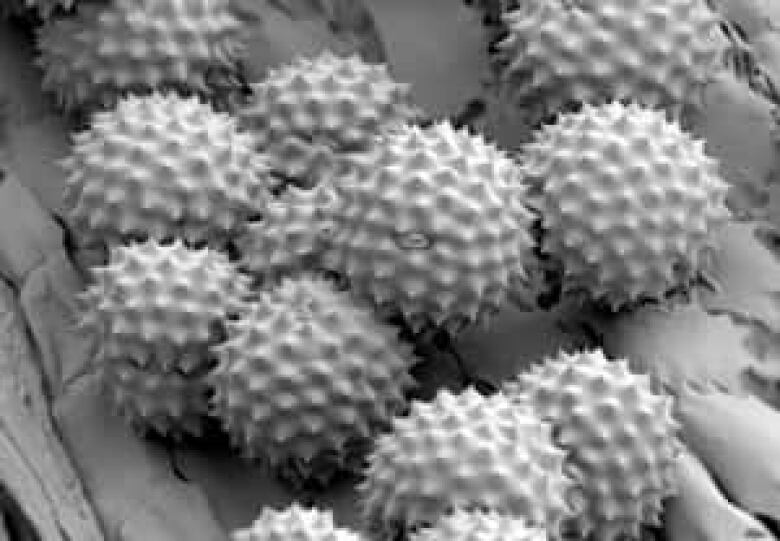Allergies: why we get them
Investigating clues to a modern medical mystery with two experts in the field
Why some people have allergies remains a modern medical mystery. Why should the body react so powerfully to something in nature that's not harmful? And why just a minority of people, although the number of allergy sufferers is increasing rapidly.
In the last couple ofdecades, scientists have been getting closer to finding an explanation, although it remains "the $60-million question " for Mark Larch, the Canada research chair in allergy and immune tolerance atMcMaster University in Hamilton, Ont.
Mistakes happen, allergies follow
When someone has an allergic reaction to something that is not harmful, perhaps pollens that cause seasonal allergies, it's like their immune system has made a mistake.

After we're born, our immune systems have to learn what's harmful and what's not. Curiously, we generally don't become allergic to pollens during the first five or six years of life.
"Nobody's really sure why it takes those first few years," Larch said in an interview with CBCNews.ca.
An allergic response is produced by what's called an allergen. In the case of seasonal allergies, the allergen is one or more of the proteins in a pollen.Although he can't say why pollen allergies don't develop until the fifth or sixth year, Larch can say that they often firstdevelop in conjunction with a viral infection.
"There's quite good evidence that in kids who get infected with particular viruses that affect the nose and lungs, the particular timing of that infection coincides with a heavy exposure to an inhaled allergen like ragweed," he said.
The coincidental viral infection causes its damage, interfering with the normal sensitization process. Then the immune system reacts to the proteins as a threat, which it normally would not do.
However, this is not just a one-off case of bad timing. Once the allergic reaction happens, it is established as the pattern the immune system will follow when it encounters those proteins again in the future. The same pattern will be instigated when theimmune system encounters similar proteins, part of the explanation for why people have multiple allergies.
When does allergy start?
For Judah Denburg, who heads AllerGen, Canada's allergy research network,the big questionnow in his fieldis, "when does allergy first start?.Answering thatquestion, is "really critical," he said.
"That unlocks a lot of doors," says Denburg,"because if you know that, you know something about the timing, the family, the maternal influences, the environment and, certainly, the genes."

In pursuit of an answer to that allergy mystery, researchers in Canada, a world leader in allergy science, and elsewhere are now measuring infant lung function and studying infants' immune systems long before they can be diagnosed with allergies or asthma.
Scientists have long known that genetics and the environment are part of the answer to why people get allergies, but only a part.
A child whose parents have allergies is more like to develop allergies. Scientists have been learning more about the association of certain genes with allergies, but what's most important is to learn about the genetic interaction with the environment, said Denburg.
"Put the wrong genetic makeup into the wrong environment, and you get this explosive mixture that leads to allergies and asthma," he said.
In order to determine whichcombinations of genetics and environment are the mostlikely to cause allergies, researchers are collaborating in global studies of populations with known susceptibilities to allergensin placeswhere the exposure to things like pollens and pollutants is also known.
The downside of keeping clean
Meanwhile, allergy rates are going up much faster than genetics can account for. Some experts call it an epidemic.
One theory is the hygiene hypothesis: that in childhood, we are not being exposed to enough pathogens for our immune systems to learn how to best respond.

Generally in biology, an allergic response is useful, says Larch.It evolved to protect us from parasitic worms, a common problem up until about 100 years ago, and is effective when it comes to getting rid of parasites.
But thanks to our hygienic homes and lifestyles, "it's almost like the immune system is looking for something to do," Larch explained. As a result, it attacks harmless substances as if it were confronting parasites.
For Larch, it's clear that kids were designed to roll around in the mud. In fact, putting things in one's mouth might be an innate response for infants, he said. Our immune system becomes aware of things by encountering them.
"Early on, we were programmed to interact with bacteria in the soil, for example," Larch said.
That's because soil bacteria are closely related to bacteria that cause diseases like tuberculosis and leprosy.
The hygiene hypothesis appears to be backed up by the fact that allergy rates arehigher among urban populations; children who don't have any siblings; and in so-called developed countries and that the ratesincrease as countries develop.
Allergies similar to autoimmune diseases
The incidence of chronic immunological diseases like Type 1 diabetes and multiple sclerosis is increasing similarly to that of allergies and asthma.In those diseases, sufferers develop anexaggerated response to their own tissues rather than to a foreign protein.
Larch argues that our immune system needs early exposure to pathogens "in order to understand how to regulate an immune response and make sure we don't go overboard with an immune response to any given protein [or tissue]."
Of course, an immune response to something dangerous is essential. Someone with allergies has an immune system that is unable to control that response.Larch compares it to a child having a temper tantrum.
"You learn to regulate the degree of fury as you get older, and we are failing to do that with our immune system," Larch said.
New allergy treatment
As scientists learn more about why people develop allergies, they are coming up with new treatments. Denburg says a vaccinethat Larchand his team areworking onseems especially promising.

To make the vaccine, researchers isolate the protein in the allergen that causes the allergic reaction and deconstruct that molecule. Then, the regions of the protein that activate infection-fighting cells are used to make a vaccine. Larch and his team have already developed such a vaccine for a cat allergy.
To do so they took blood samples from people who are allergic to cats, or more precisely, to a protein cats spread on their fur when they lick themselves. Normally, the immune system recognizes the protein as not a threat. By including just part of the protein, which is produced artificially, the vaccine is supposed to re-educate an immune system that sees the protein as a threat and responds.
Larch and Denburg both expressed hope this treatment approach will work for other allergies andsome autoimmune diseases.
Ninety years ago, Encyclopedia Americana's entry on hay fever read: "Scientific men have been, for some time, making investigations which may eventually lead to the discovery of a radical cure."
Asresearchers learn still more in the next few years about why we get allergies, perhaps that predictionwill finally come true. But more likely, it will be in the form of a treatment rather than a cure.












_(720p).jpg)


 OFFICIAL HD MUSIC VIDEO.jpg)
.jpg)



























































































